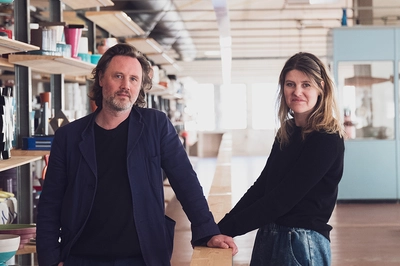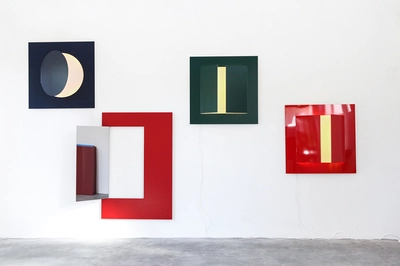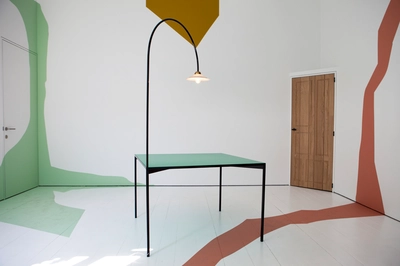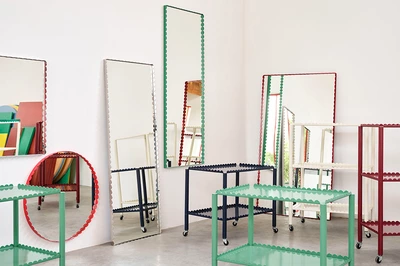
Please install a more recent version of your browser.
29 August 2023
5 minutes read
On 7 September, Muller Van Severen will be honoured as Designer(s) of the year by Maison&Objet. Maison&Objet rewards them for a ‘decade of innovation that shook up the codes of interior design’. Their presentation at the fair is based on key elements of their daily life: home, workplace and garden, with of course an overview of their products. We visited them in their habitat, in Evergem near Ghent.

Hannes Van Severen and Fien Muller
Muller Van Severen's story begins in 2011. As a couple, they share life, home and studio. In the studio, each has his part. Hannes, as a sculptor, transforms objects there. Fien, also trained as a sculptor and photographer, is mainly known as a photographer. But there is a clear link in their work. Both create landscapes, installations, explore space. And there is a desire to make utilitarian objects together. Then comes an invitation from Veerle Wenes of gallery Valerie Traan in Antwerp to exhibit together.

Frame, Muller Van Severen
Both descended from artistic families, they share an interest in design classics, without really keeping up with the design world, the latest design trends. As artists, they feel paralysed by the many possibilities within visual art. They do not know the limits to which design obliges them. The fact that functionality imposes restrictions on them, they themselves feel as a great freedom. Something is being added.
At Valerie Traan, they present in 2011 an installation together, A Furniture Project. Wall, floor, ceiling connect them with their objects. The transparency of it all accentuates their presence in the space. Objects disappear and appear. Whereas this expo was originally meant to be something one-off, it gives them such a satisfying feeling that they decide to continue working together. Has anything changed in the way they work as designers? They still start their designs with drawings. They sculpt a space.

A Furniture Project, Muller Van Severen, Valerie Traan
Hannes and Fien are very grateful to Veerle for the carte blanche they got from her. Later, with Valerie Objects, some objects also became more commercial and accessible to everyone. But they don't want to be stuck with one person, which is why they also work with international galleries. Recently, there was the collaboration with the Tim Van Laere Gallery in Antwerp. They had to go and deliver a work there, a good chat followed, and... A request from Veerle or from Tim will also be completely different. So they don't see it as competition themselves. This just opens up new perspectives.
For several years, Muller Van Severen worked on interior projects such as for Camper and the SMAK in Ghent. The cancellation of the VRT redesign project for budgetary reasons was a disappointment. In recent years, they have focused more on new objects for major international brands. They are contacted by these companies themselves. Although they took the first step towards Hay themselves after hearing that there was interest in their design from them.
Their work is particularly popular in Scandinavian countries. Hence the collaborations with Hay, Kvadrat and Reform, but it also catches on elsewhere. Brands like CC Tapis, Wallpaper or Bitossi contact them. Why do these companies come to them? Their own identity is extremely important. And what is it? Solving things in a simple way. How do you give a metal sheet a function? By cutting them open, you suggest a window. The Frame collection gets a function as a mirror or lamp. Designs are honest, intelligible, direct. Nothing is hidden.

Ceiling Lamps, Muller Van Severen
Characteristic is the use of colour and materials. The materials used are honest: leather, copper, steel, marble. But polyethylene is also a grateful material. They prefer to work with local craftsmen and workshops. They want colours to penetrate to the core of the object. Paints are applied in textured layers, giving the designs a natural look. Enamel gives the same effect. Colour is sometimes determined in advance, sometimes afterwards. Their choice is an obvious one, a kind of instinct, averse to all trends.
They would love to spend more time searching and experimenting with new materials, but little time remains for that. Now it is rather opportunities they encounter on their way to explore new materials, such as a first contact with the Emaillerie Belge (as part of the Belgium is Design exhibition Belgian Matters in 2016), with marble at Van Den Weghe or ceramics by Bitossi.
There is not really a difference in design process for industrial products and for gallery work. At least not for Fien, she still starts making drawings. Hannes also designs on computer. But in the end, models are still made in paper, cardboard or clay. When Bitossi asked to design a vase, they cut a mass of shapes in A4 paper. Determining the limits of the project, the strongest shapes were selected. With large production, aspects such as transport must also be taken into account. Most importantly, the final result has an individuality that typifies both Muller Van Severen and for Hay. You create for yourself, but also for others.

Arcs Trolley/Mirror, Muller Van Severen voor Hay
Muller Van Severen receive an award and an expo at Maison&Objet. With this, they want to attract a wider audience. Show both unica, which are less known to the wider public, and the known products for the bigger brands. Such an award is also a confirmation for themselves. As a designer, you always live with a certain uncertainty. Awards are a reward. The fact that you get to design for a company like Hay is also a turning point in your career. You no longer design for one kind of audience. You make a product that is affordable for everyone.
According to Muller Van Severen there is often a lot of sameness at trade fairs. There is more and more copying. Yet it is striking that major labels always attach great importance to creativity.
When asked if they want to grow, the answer is that they definitely don't want to work with a lot of staff. They also find it hard to delegate. In fact, they are on retreat in their own world. They also want to make this clear through their presentation at Maison&Objet. As an installation, Oasis is a reflection of their lifestyle. It is a room with three entrances and with three islands. The corridor between them is inspired by the path in their garden. Oasis reflects the peace they find at home, their universe, a bit separated from the world. Fien and Hannes enjoy going to the city, which is nearby, but would not be able to work there. You have to be able to isolate yourself to think freely.

Stand Muller Van Severen, Maison&Objet
Finally, we ask them what Belgian design is and how they frame themselves. Typically Belgian is the fact that Belgian design does not really have an identity. If an identity has to be sought, it is surrealism. We live in the land of Magritte. This was also present in Hannes' earlier work with its transformed cabinets. The Frame collection, for example, poetically refers to a window, yet also a form of surrealism.
Maison&Objet runs from 7 to 11 September at Parc des expositions Paris Nord Villepinte. You can read more about the award on the site of Maison&Objet, where you can follow a masterclass with Muller Van Severen.
You can watch our video with Muller Van Severen.
Cookies saved